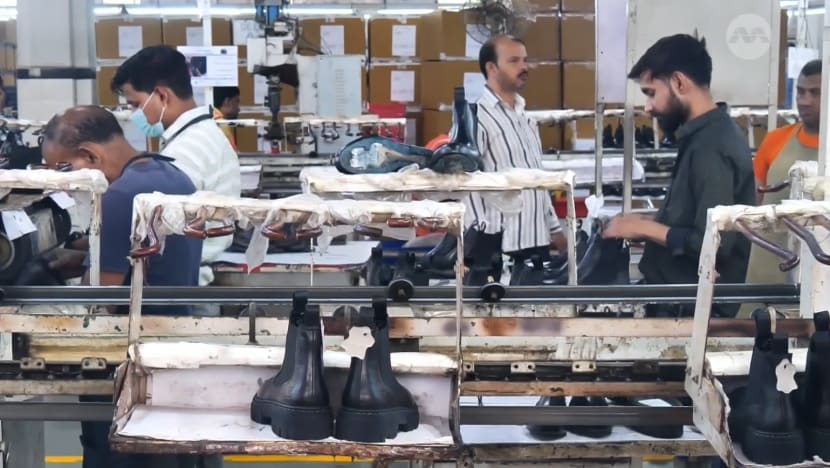Small businesses not reaping the rewards of PM Modi’s flagship ‘Make in India’ scheme
CNA travelled to Agra in Uttar Pradesh state to find out if Mr Narendra Modi’s marquee project is a hit or miss among voters in the ongoing general election.

A leather footwear factory in Agra, Uttar Pradesh, India.

This audio is generated by an AI tool.
AGRA, India: As Indian Prime Minister Narendra Modi seeks a rare third term in power, small business owners in the country’s most populous state said that they feel mostly cut off from one of his flagship projects.
Mr Modi launched the “Make in India” campaign in 2014, aimed at transforming the world’s fifth-largest economy into a manufacturing hub. But only in the last two years have chief executives and governments started to pay close attention.
The city of Agra in Uttar Pradesh state, made famous by the Taj Mahal, is among those directly benefiting from the campaign.
For example, its new metro trains were built by French manufacturer Alstom in Gujarat state under this scheme and are already in service. Residents also said it has created more jobs.
However, some said schemes like these do not apply to the poorest in India and have not benefited small businesses, with many still relying on their traditional craftsmanship to lure domestic customers.
WHAT DO VOTERS IN AGRA THINK?
CNA travelled to Agra, situated in the western part of Uttar Pradesh about 200km from the capital New Delhi, to find out if the “Make in India” initiative is a hit or miss among voters going to the polls this week.
India is in the midst of the world’s largest general election that began on April 19 and is set to end on June 1.
Nearly a billion people are eligible to vote, which is more than the combined population of all European countries as well as the total population of all nations in Southeast Asia.
Uttar Pradesh, with more than 240 million residents, accounts for 16.5 per cent of the country’s population.
More than 80 per cent of Agra residents are Hindus, with thousands more from the minority community – meaning that the city has an outsized impact on the general election results.
This is also why the federal government has made a concerted effort to prop up Uttar Pradesh as India’s next big driver of growth.
Voters in Agra told CNA that apart from manufacturing gains, they support their city becoming part of India’s ambitious defence industrial corridor that aims to transform the nation into a net defence supplier.
“We were dependent on countries like Japan for mechanical goods, but now we’re making them ourselves. We’re making our own fighter jets and missiles too,” said resident Awadhesh Dubey.
Another resident, Mr Krishna Kant Verma, called the “Make in India” scheme a “great project” that helps to generate employment.
RELIANCE ON BIG FIRMS
To drive India’s growth and employment numbers, the government is relying on big domestic and international firms to jump on the scheme.
Electronics giant Samsung set up its largest mobile manufacturing plant in 2018 on the outskirts of New Delhi, while another South Korean giant, Hyundai Motors, is also investing about US$1.5 billion to set up an electric vehicle plant in the same state.
Meanwhile, India’s biggest car company, Maruti Suzuki, has used the scheme to export its cars across the global south.
The Indian subsidiary of Japanese automaker Suzuki was established by the government in 1981 as the country’s first big push towards making cars affordable. It is an example of what Mr Modi hopes from his marquee project.
However, questions remain over high unemployment numbers. Mr Modi’s Bharatiya Janata Party (BJP) government has not clarified how many jobs the “Make in India scheme” has created.
Its periodic labour force survey puts the unemployment rate between 2022 and 2023 at 3.2 per cent, while a report from the International Labour Organization released days before the survey said that youths make up 83 per cent of India’s unemployed.
LEATHER A KEY INDUSTRY IN AGRA
Analysts said that traditional and labour-intensive industries, like leather and textile, can help tackle unemployment better than the tech and services sectors.
In Agra, the indigenous leather industry is a key source of employment. It makes about 30 per cent of all leather shoes produced in India.
One of the biggest players is Dawar Group, which has more than 1,500 staff and sells its footwear both domestically and abroad.
The company said it has benefitted from the BJP government’s business-friendly policies, which include simplified processes to get permits, lower corporate taxes, and easier insolvency procedures.
However, the high cost of production for the labour-intensive sector means it is difficult to earn high profits.
Dawar Group founder Puran Dawar noted that the capital cost in India is much higher compared with other countries.
“The world is getting it at 0 to 2 per cent. We are working at 8 to 10 per cent, so futuristic growth or scaling up … it becomes a little difficult,” he said.
The problems are even greater for those dreaming on a shoestring budget. Mr Naval Kishore, who works in the Dawar factory, said schemes like “Make in India” do not apply to the poorest.
According to him, he failed multiple times in starting his own venture after working in the sector for decades. The authorities had cancelled his loan application, saying he was not generating any employment and needed to have a small business to begin with.
Small businesses in Agra’s famed leather market similarly said they feel mostly cut off from the scheme, having failed to reap any rewards from it.
Nevertheless, economists believe such policies will gradually help people like Mr Naval and small business owners.
“This question is linked to how quickly the effects of markets sort of trickle down all the way down to the hinterland that you're seeing in the rural areas,” said Dr Rajat Kathuria, dean of the Shiv Nadar University’s School of Humanities and Social Sciences.
“Trickle-down happens on its own, but happens very slowly,” he added.



















